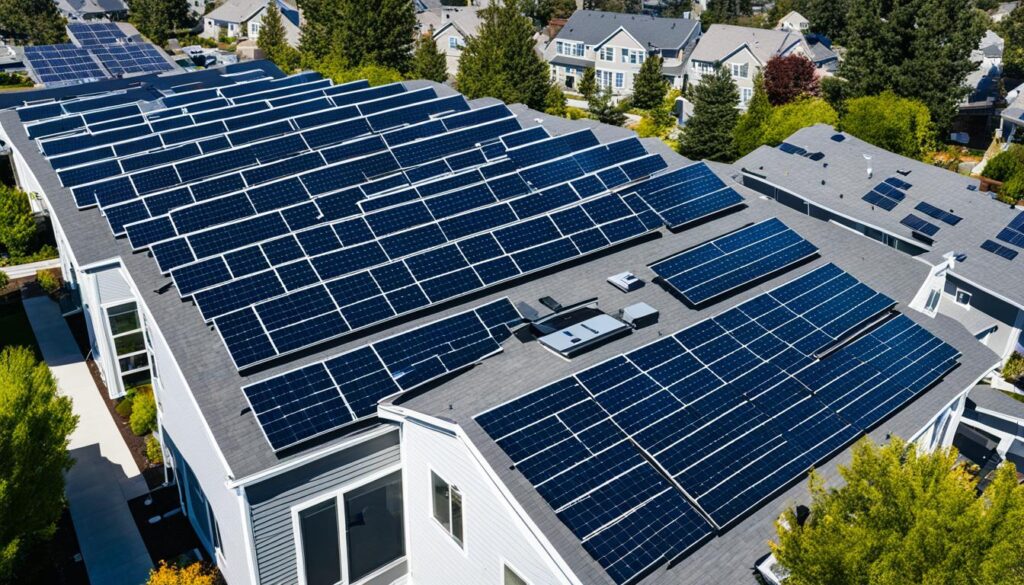The world is turning to Green Energy, and Solar Power for Home is getting popular in India. Homeowners want to cut down on carbon emissions and save on electricity bills. This piece looks into the solar for home cost. It talks about what affects the price and how to get the most out of your investment.
Key Takeaways
- Understand the key factors that impact the cost of a residential solar panel installation system, such as system size, equipment quality, and installation complexity.
- Explore strategies for calculating the ROI of a home solar investment, including the impact of government incentives and energy savings.
- Discover financing options and incentives that can make solar energy more accessible and affordable for Indian homeowners.
- Learn about the long-term benefits of switching to solar power, including reduced energy costs and increased property value.
- Gain insights into the latest trends and advancements in the solar industry that are driving down the cost of residential solar systems.
Understanding the Cost of Residential Solar Panel Systems
Getting a residential solar panel system is a smart step towards using green energy and cutting down on bills. But, it’s important for homeowners to know what affects the cost. Things like the system’s size, the gear needed, and the work and permits add up to the total cost.
Factors Influencing Solar Panel Installation Costs
The price of putting in solar panels can change a lot. The size and capacity of the solar system are key factors. Bigger systems need more solar equipment and hardware. Also, the cost of labor and permits for installing it matters a lot.
Homeowners should think about the ongoing costs of keeping the solar system running. Solar panels last a long time but need cleaning and sometimes repairs to work well. Keeping an eye on home electricity use and utility bill savings helps figure out the payback over time.
Calculating the Return on Investment for Home Solar
Figuring out the return on investment (ROI) for home solar is key to seeing the long-term benefits. Homeowners can use solar tax credits and rebates to lower the upfront cost. By looking at utility bill savings and these incentives, homeowners can decide if solar energy is right for their homes.
| Cost Factors | Average Range |
|---|---|
| Solar System Size and Capacity | $3,000 – $15,000 |
| Solar Equipment and Hardware | $10,000 – $25,000 |
| Labor and Permitting Expenses | $2,000 – $5,000 |
| Solar Energy System Maintenance | $100 – $500 per year |

Solar For Home Cost: Breaking Down the Expenses
Thinking about solar energy for your home is a big step. Knowing the costs can help you decide better. The average cost of solar panels per watt is key, as it affects the total cost.
The total cost includes the panels, inverters, wiring, and mounting gear. Labor and permits also add to the price. But, there are ways to pay less upfront, like solar leasing and power purchase agreements.
| Expense Category | Average Cost |
|---|---|
| Solar Panels | Rs. 30,000 – Rs. 60,000 per kW |
| Inverters | Rs. 15,000 – Rs. 40,000 per kW |
| Mounting System | Rs. 5,000 – Rs. 15,000 per kW |
| Wiring and Electrical | Rs. 10,000 – Rs. 20,000 per kW |
| Labor and Installation | Rs. 20,000 – Rs. 40,000 per kW |
| Permits and Fees | Rs. 5,000 – Rs. 20,000 per system |
The Indian government gives government incentives and subsidies to support renewable energy. These help lower the cost of rooftop solar expenses and make it more profitable for homeowners.
Understanding the solar panel cost calculator and solar financing options helps Indian homeowners choose solar energy wisely. This way, they can enjoy its long-term benefits.
Conclusion: Making Solar Energy an Affordable Investment
The cost of solar energy for homes in India is getting lower. This makes it easier and more appealing for homeowners to switch. The savings over time and the good it does for the environment are big reasons why more people are choosing solar power.
Things like how well solar panels work, government help, and making more panels have lowered costs. Homeowners can now think about the benefits and decide if solar power is right for them.
The future looks bright for green energy costs in India. New technology, making more panels, and government support will make solar power for green energy even more solar panel affordability. As more homes go solar, we’ll see big benefits for the planet and big savings for homeowners. This will make solar incentives and rebates a smart choice for Indian families.
FAQ
What factors influence the cost of a residential solar panel system?
The cost of solar panels for homes depends on several things. These include the system’s size and capacity, the type of panels and equipment, and labor and installation costs. Taxes, permits, and maintenance costs also play a part.
How can I calculate the return on investment (ROI) for a home solar energy system?
To figure out the ROI for home solar, consider the system’s upfront cost and the savings on energy bills each year. Don’t forget about tax credits or incentives and the panels’ lifespan. This helps you see the payback period and long-term gains.
What are the typical costs associated with a residential solar panel installation?
Installing solar panels at home can cost a lot, but the average price in India is about ₹60,000 to ₹1,00,000 per kilowatt (kW). This covers the panels, inverters, mounting gear, and installation labor.
What financing options are available for homeowners to install solar panels?
Homeowners can finance solar panels through loans, leases, power purchase agreements (PPAs), or cash. Loans let you own the system after financing it. Leases and PPAs mean a third party owns and maintains the system for monthly payments.
Are there any government incentives or rebates available for residential solar installations?
Yes, homeowners can get government incentives and rebates for solar panels. These include tax credits, net metering programs, and subsidies. These incentives can lower the cost of solar energy systems and boost the ROI.
How does the size and capacity of a solar energy system affect the cost?
The cost of a solar system goes up with its size and capacity, measured in kilowatts (kW). Bigger systems cost more upfront but can save more on utility bills over time.
What are the ongoing costs associated with maintaining a residential solar energy system?
Keeping a solar system running is usually cheap, about 1-2% of the total cost each year. This covers maintenance, cleaning panels, and sometimes replacing or fixing equipment.

